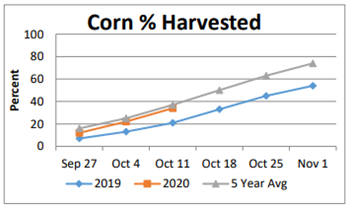October 16, 2020
Crop Scout
The area is off to a great start with fall harvest. Yields reports have been excellent overall for early planted corn and beans. As of October 11th, Indiana has harvested 52% of the soybeans and 34% of the corn for grain. Some areas seem to be a bit farther ahead due mainly to planting time this spring.
The ground in south central Indiana is excessively hard and dry due to the lack of rain since the end of August. This has led to a lack of tillage being conducted in the area. The rains received Thursday may not be enough to move moisture to the depth of the soil profile, but time will tell. As of October 11th, 75% of the state fell into either short or very short for topsoil moisture. Several crop fires have been reported in Indiana and Illinois due to equipment fires or other means. It would be a very good idea to form a plan for how you plan to deal with a crop fire if you do face that challenge. Be sure to share the plan with your team.
Fall-Applied Herbicides
This fall you might consider applying a fall-applied herbicide. The fall is a great time to consider controlling winter annual weeds such as marestail. Marestail is one of the few weeds that is both a winter annual and summer annual. This means that it can germinate at various times of the year and its life cycle can be completed in either the fall-winter-spring or the summer months. Fall provides the opportunity to control small winter annual weeds and have cleaner fields next spring. The best way to know whether you need a fall application of herbicide is to scout your fields. Get out and look for emerging winter weeds and determine whether they warrant control. Start scouting as soon as you harvest a field and pay close attention to fields that have had heavy marestail issues. When applying foliar herbicides, the best and quickest results are often achieved by spraying when you have several days with temps above 50 degrees. However, those days are not always available in November. If overnight temperatures stay above freezing, it is often OK to apply a herbicide. For applications to corn stalks, increase spray volume or decrease spray speed to help make sure you get good coverage. Herbicides that are common to be sprayed in the fall are 2-4D, dicamba, metrobuzin, and glyphosate. Metrobuzin is a residual that is often added when applying early in the fall to carry control through until ground freezes. One program that is popular is metrobuzin, 2-4D, and dicamba. This provides excellent upfront control of weeds and a residual to keep the fields clean until ground freezes. Programs for the fall may cost around $7 – $9 per acre before application costs. Fall herbicides provide a great inexpensive way to control weeds heading into spring and start out on the right foot for the upcoming crop season. Check replant restrictions and always read and follow label directions. If you have any questions, reach out to our team or your ag retailer.
Resources
- October 13th Indiana Crop Progress Report.
- Purdue Fall Applied Herbicides

